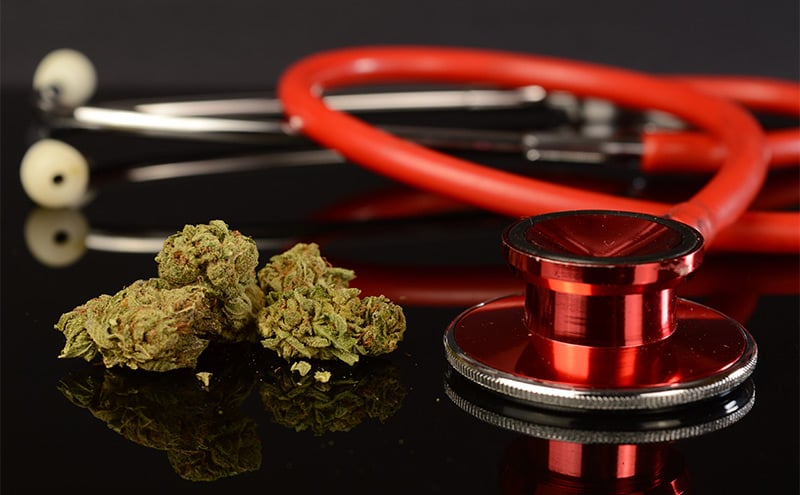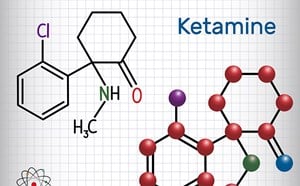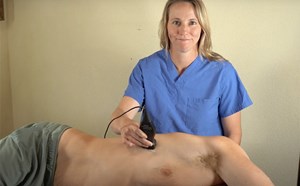
Marijuana Pain
The endocannabinoid system in involved in pain modulation through direct and synergistic effects on descending supraspinal pathways involving endocannabinoids, TRPV, PPAR, endorphins, enkaphalin and inflammatory mediators. Cannabinoid effects are mediated through CB1 and CB2 receptors. CB1 localizes presynaptically in the peripheral and central nervous systems and mediate the behavioral and psychotropic effects of cannabinoids. CB2 are primarily found peripherally and mediate immunologic responses; it may mediate pain relief through dopamine modulation. The active molecules in marijuana are delta-9-THC (a partial agonist at CB1 > CB2), CBD, terpenes, and flavonoids. THC reduces NMDA responses leading to decreased excitatory stimulation in pain pathways. THC was shown to have more anti-inflammatory effects by a factor of 20 when compared to aspirin and a factor of 2 when compared with hydrocortisone. While there are significant patient responses to cannabinoids in certain epileptic syndromes, insomnia, anxiety, and spasticity, the literature remains mixed regarding efficacy, dosage and regarding its effect on pain.
Migraine, HA, Facial Pain
- In a double-blind cross-over study with 8-week washout, nabilone 0.5mg daily was superior to ibuprofen 400 mg in treating medication overuse headache
- 2017 European Academy of Neurology evaluated cannabinoids for chronic migraine and cluster headaches. Phase 1 determined oral dose of 200mg THC-CBD decreased acute pain intensity by 55%. Phase 2 included 79 patients and showed that prophylaxis with the above dose led to 40.4% improvement versus 40.1% improvement using amitriptyline. Additional of 200mg THC-CBD provided no benefit to cluster headache attacks.
- 121 adults in medical marijuana clinics in Colorado retrospectively reviewed had a mean decrease from 10.4 to 4.6 (p < 0.0001) migraines per month with 85% of participants reporting a decrease in frequency of migraines.
Chronic pain
- 2011 systematic review of 18 studies evaluating 925 patients with chronic pain showed 83% of studies had positive results. Chronic pain diagnoses evaluated included neuropathic pain, fibromyalgia, and rheumatoid arthritis. A 2015 update by the authors added an additional 11 studies including 1135 patients where 64% (7/11) of studies had positive outcomes in reduction of daily analgesic intake, pain intensity, spasticity, MS pain.
- 2015 JAMA meta-analysis of 79 trials determined moderate-quality evidence for cannabinoid use in chronic pain, neuropathic pain and spasticity in MS.
Synergism with other analgesics and societal impact
- CB1 has shown to be 10x more concentrated than mu-opioid receptors which has been shown to co-localize in pain circuitry.
- The addition of vaporized cannabis to a patient’s morphine or oxycodone regimen led to a decrease in the ED50 of morphine by a factor of 3.6 or ED50 of codeine by a factor of 9.5.
- Legislation of medical cannabis is correlated with a 24.8% decrease in opioid overdose mortality; the average effect was shown to increase on a yearly basis ranging from 19% in the first year after implementation to 33.3% at year 6.
References
- Baron E. Medicinal properties of cannabinoids, terpenes, and flavonoids in cannabis, and benefits in migraine, headache, and pain: an update on current evidence and cannabis science. 2018 Jul;58(7):1139-86. doi: 10.1111/head.13345.
- Bachhuber MA, Saloner B, Cunningham, et al. Medical cannabis laws and opioid analgesic overdose mortality in the United States, 1999-2010 . JAMA Intern Med. 2014;174(10):1668-73. doi:10.1001/jamainternmed.2014.4005.
- Rong C, Lee Y, Carmona N, et al. Cannabidiol in medical marijuana: Research vistas and potential opportunities. Pharmacological Research 2017;121:213–8.
- Stevens AJ, Higgins MD. A systematic review of the analgesic efficacy of cannabinoid medications in the management of acute pain. Acta Anaesthesiol Scand. 2017 Mar;61(3):268-80. doi: 10.1111/aas.12851.
- Starowicz K, Finn DP. Cannabinoids and pain: sites and mechanisms of action. Adv Pharmacol. 2017;80:437-75. doi: 10.1016/bs.apha.2017.05.003.
- Pini LA, Guerzoni S, Cainazzo MM, et al. Nabilone for the treatment of medication overuse headache: results of a preliminary double-blind, active-controlled, randomized trial. J Headache Pain. 2012;13:677-84.
- Nicolodi M, Sandoval V, Terrine A. Therapeutic use of cannabinoids - dose finding, effects, and pilot data of effects in chronic migraine and cluster headache. Abstract presentation at 3rd Congress of the European Academy of Neurology (EAN), Amsterdam, June 24, 2017.
- Rhyne DN, Anderson SL, Gedde M, et al. Effects of medical marijuana on migraine headache frequency in an adult population. Pharmacotherapy. 2016;36:505-510.
- Martin-Sanchez E, Furukawa TA, Taylor J, et al. Systematic review and meta-analysis of cannabis treatment for chronic pain. Pain Med. 2009;10:1353-68.
- Aggarwal SK. Cannabinergic pain medicine: a concise clinical primer and survey of randomized-controlled trial results. Clin J Pain. 2013;29:162-71.
- Lynch ME, Campbell F. Cannabinoids for treatment of chronic non-cancer pain; a systematic review of randomized trials. Br J Clin Pharmacol. 2011;72:735-44.
- Hill KP. Medical marijuana for treatment of chronic pain and other medical and psychiatric problems: a clinical review. JAMA. 2015;313:2474-83.
Nicholas Mota, DO


